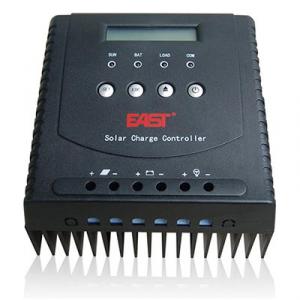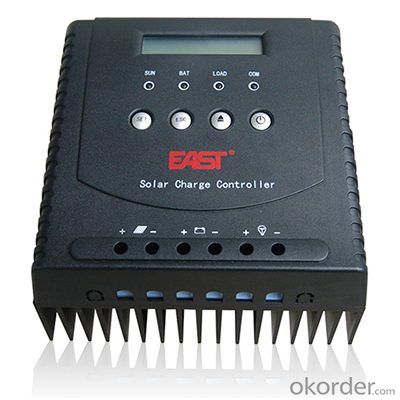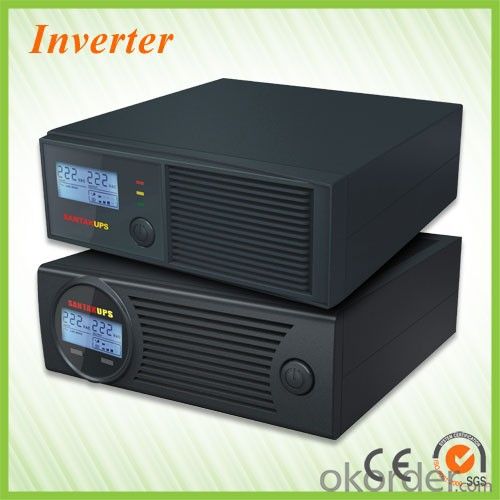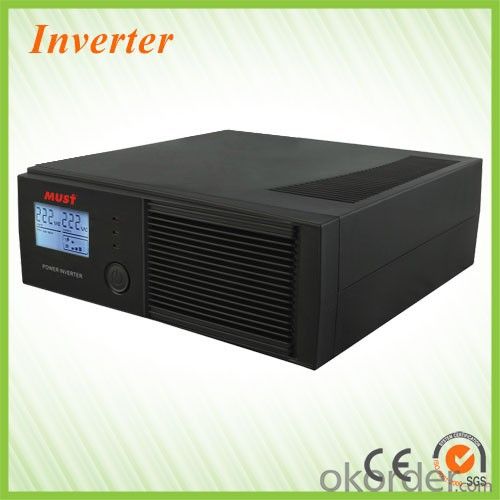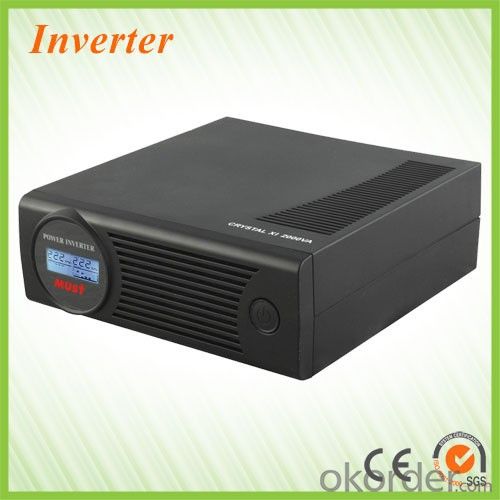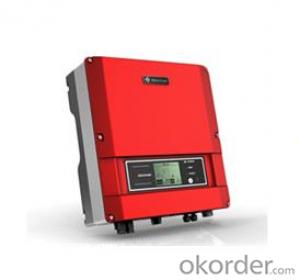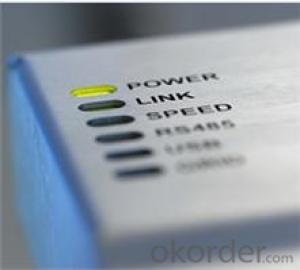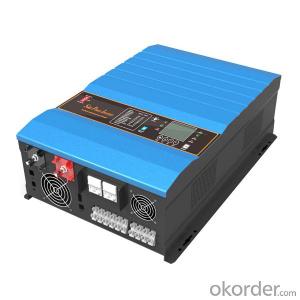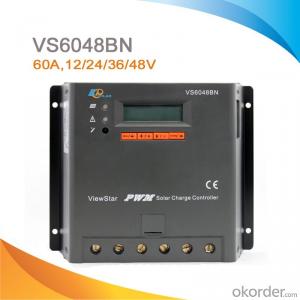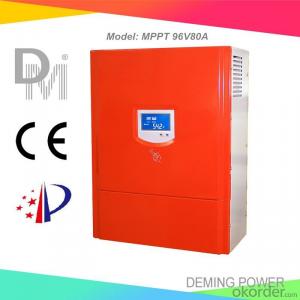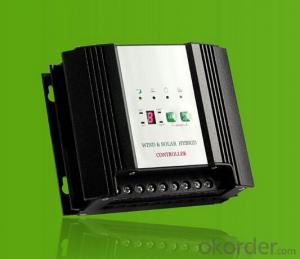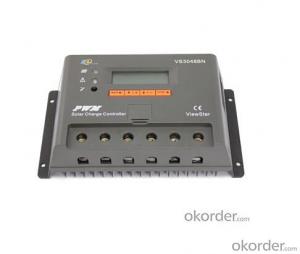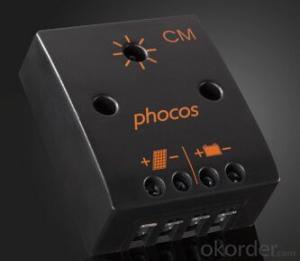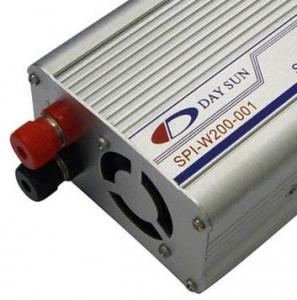Solar Inverter System Solar Charge Controller LCD 10A-60A
- Loading Port:
- China main port
- Payment Terms:
- TT or LC
- Min Order Qty:
- 1 pc
- Supply Capability:
- 1000 pc/month
OKorder Service Pledge
OKorder Financial Service
You Might Also Like
Solar Charge Controller LCD 10A-60A
This is a highly intelligent charge controller with (MPPT). The optimal and intelligent “MPPT + SOC” charge control is implemented. The power switching components consist of low-loss MOSFET type transistors that have a long operating life and guarantee high performance. The extremely low own consumption makes it especially suitable for solar home systems, solar street lamp system, advertising lighting, traffic management system, and other professional applications etc. With the reverse polarity protection, lightning protection, electronic fuse and automatic detection of faulty battery, the controller is robust, maintenance-free and user-friendly.
● Intelligent operation: the system will automatically start PV charging function without the manual operation.
● High efficiency MPPT function (optional): the system adopt maximum power point tracking technology, even if the battery using in the different condition, this MPPT controller could ensure the Maximum output power from the PV panels, and increase 20-30% electrical power using efficiency from solar panel.
● Reliability: Adopt the Hybrid controller to realize “MPPT+SOC” double intelligent charge control, ensure the product stability and reliability.
● Intelligent charge control: With automatic battery temperature compensation, constant current and constant voltage integrated charge mode, improve the battery's charging efficiency and working life.
● Battery protection: automatically detect the battery working condition, when overdischarge, the system will be shut down automatically, avoid wasting the battery energy.
● High efficiency: Power loop adopts low-loss MOSFET type transistors in series, PWM Soft switching technology is applied to reduce switching loss, Synchronous rectification technology is applied to decrease voltage drop, increase the system's efficiency.
● Intelligent: Illumination recognition auto power on(optional): the system can be set to auto turn on the load when lack of sun, such as fog,storm,night. Auto turn on the load, it is a good assistant of transportation illumination.
● Protection: Overcharge protection/ Over-discharge protection / Battery Reverse Current Protection / Overloading Protection/ Short
● Circuit Protection/ Reverse Polarity Connection Protection/ TVS lightning protection etc.
● LCD Display: to show the working mode of solar battery, seal-lead acid battery and load.
● Well Adaptability (optional): through the man-machine interface, charging current fine adjustment can be settable, suitable for Li-ion Battery, lead-acid battery and other storage system.
● Intelligent communication (optional): RS232 and dry connect
● Temperature compensation (optional): with external battery working temperature detective port, to adjust the charging voltage in time according to the battery working temperature
Model | F2448-10/M | F1224-20/M F2448-20/M | F1224-30/M F2448-30/M | F1224-40/M F2448-40/M | F1224-50/M F2448-50/M | F1224-60/M F2448-60/M |
System Voltage | 12V / 24V ;24V/ 48V | |||||
Rated Charging Current | 10A | 20A | 30A | 40A | 50A | 60A |
Rated Load Current | 10A | 20A | 30A | 40A | 50A | 60A |
PV Panels Configuration (Suggestion)(Imp≤Rated Current) | ≤10A | ≤20A | ≤30A | ≤40A | ≤50A | ≤60A |
Battery Capacity | 38Ah~800Ah | |||||
Max. Efficiency | > 98% | |||||
Static Dissipative | < 0.5%(system rated current) | |||||
Solar Battery Port Input Voltage | 12V:0-24V;24V:0-48V;48V:0-95V | |||||
Rated Battery Voltage | 12V / 24V ; 24V / 48V | |||||
Buck Charge Voltage | 14.6V / 29.2V±1% ; 29.2V/58.4V±1% | |||||
Float Charge Voltage | 14.4V / 28.8V±1% ; 28.8V/57.6V±1% | |||||
Overcharge Protection | 14.7V / 29.4V ±1% ; 29.4V / 58.8V±1% | |||||
Charging Resume Voltage | 13.2V /26.4V±1% ; 26.4V / 52.8V±1% | |||||
Undervoltage Alarm | 11.2V /22.4V±1% ; 22.4V / 44.8V±1% | |||||
Overdischarge Protection | 10.8 V / 21.6 ±0.3V ; 21.6V / 43.2 ±0.4V | |||||
Overdischarge Resume Start Voltage | 13.2 V / 26.4 ±0.3V ; 26.4 V / 52.8 ±0.4V | |||||
discharge Circuit Voltage Drop | < 5 %(System rated voltage) | |||||
Overload, Short-Circuit Protection | 125%(60S) / 150%(10S)/ short-circuit auto shut down; | |||||
PV Reverse Polarity Connection Protection | YES | |||||
Display | LCD + LED | |||||
Alarm Mode | sound(optional)/light alarm | |||||
Control Mode | Switch control / PWM | |||||
Working Temperature | c-20℃ ~ +45℃ | |||||
Relative Humidity | 0-95%(noncondensing) | |||||
Storage Temperature | -25℃ ~ +85℃ | |||||
Altitude | 1000m with rated power (increase 100m, reduce power 1%) Max.4000m | |||||
Storage Humidity | ≤85% | |||||
Installation Method | hanging vertical installation | |||||
Packing Dimension WxDxH(mm) | 164×168×55 | 164*168*100 | ||||
Weight(kg) | 0.85 | 2.05 | ||||
Packing Weight(kg) | 1.05 | 2.25 | ||||
Package | 8pcs/carton | |||||
· Q. What is an UPS and What it is for ?
An uninterruptible power supply (UPS) is a device that allows your computer or telephone switch or critical equipement to keep running for at least a short time or longer time when the primary power source is lost. It also provides protection from power surges, spikes, brownouts, interference and other unwanted problems on the supported equipment.
· Q. How long the UPS to run when power goes?
This can take 3 paths.
1.You can pick a UPS that is rated for pretty much the full VA you need so it will be running at 100% of capability and will thus last 'n' minutes.
2.You can pick a UPS that is rated at a much higher VA value than you really need so, for example, is running at 50% of capability and will thus last for longer than the UPS from option 1.
3.You can use extra external battery packs to run for longer. If charging capability allows, the more and the bigger batteries you take with, the longer time UPS runs.
or using a generator after about 6 hours, it will be more cost-effective, with a short runtime UPS to bridge the generator start-up gap.
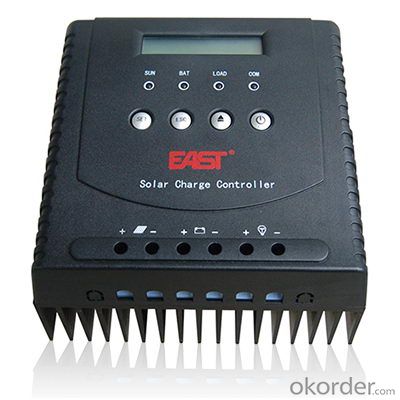

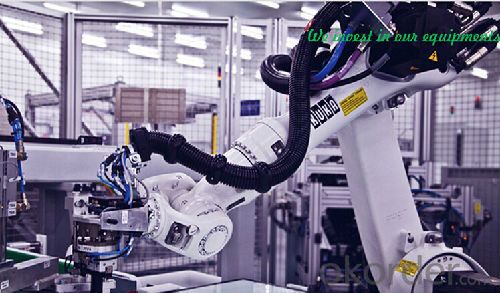
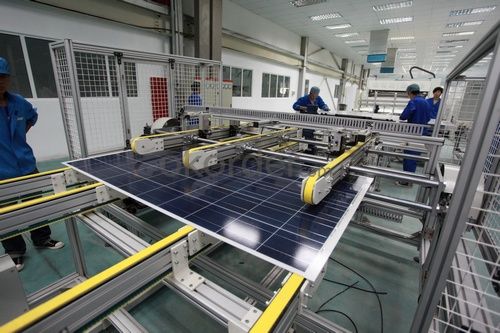
- Q: Why is a solar inverter necessary in a solar power system?
- A solar inverter is necessary in a solar power system because it converts the direct current (DC) produced by solar panels into alternating current (AC) that can be used to power electrical devices in homes and businesses. AC is the standard form of electricity used in most appliances and grid-connected systems. Additionally, a solar inverter ensures the efficient utilization of solar energy by optimizing the power output and monitoring the performance of the solar panels.
- Q: How does a solar inverter prevent reverse current flow?
- A solar inverter prevents reverse current flow by using a specialized circuitry called anti-islanding protection. This circuitry constantly monitors the grid and disconnects the solar system from it when it detects a drop in voltage or a power outage. This ensures that any excess energy generated by the solar panels does not flow back into the grid, preventing potential damage to the system and protecting utility workers during maintenance or repairs.
- Q: Can a solar inverter be used in areas with high temperature fluctuations?
- Solar inverters can generally be used in areas that experience high temperature fluctuations. These inverters are designed to function within a wide temperature range, usually between -20°C to 50°C (-4°F to 122°F), depending on the model. They incorporate temperature protection mechanisms to guarantee their durability and functionality, even in the face of extreme temperature variations. However, it is essential to acknowledge that prolonged exposure to extreme temperatures at the upper or lower limits of their operating range may impact the inverter's performance and lifespan. Consequently, it is crucial to install them correctly and perform regular maintenance to ensure optimal performance in regions with significant temperature fluctuations.
- Q: How does a solar inverter handle voltage unbalance in the grid?
- A solar inverter handles voltage unbalance in the grid by continuously monitoring the incoming voltage levels. If it detects a voltage imbalance, it automatically adjusts its internal control mechanisms to balance the output voltage and ensure stable operation. Additionally, the inverter may also employ advanced algorithms to mitigate the effects of voltage unbalance, such as reactive power compensation and voltage regulation, minimizing any potential impacts on the solar system's performance and the grid.
- Q: What are the communication protocols used in solar inverters?
- There are several communication protocols commonly used in solar inverters to facilitate communication between the inverter and other devices or systems. Some of the most commonly used communication protocols in solar inverters include: 1. Modbus: Modbus is a widely used communication protocol for industrial devices, including solar inverters. It is a serial communication protocol that allows for the transmission of data between the inverter and other devices, such as monitoring systems or data loggers. Modbus is known for its simplicity and flexibility, making it a popular choice in the solar industry. 2. SunSpec: SunSpec is a communication protocol specifically designed for the solar industry. It provides a standardized way for solar inverters to communicate with other devices, such as smart meters or monitoring systems. SunSpec supports both wired and wireless communication, allowing for easy integration of solar inverters into larger energy management systems. 3. CAN bus: CAN (Controller Area Network) bus is a widely used communication protocol in various industries, including automotive and industrial applications. It is a robust and reliable protocol that allows for high-speed communication between devices. Some solar inverters utilize CAN bus to communicate with other devices or systems, providing a reliable means of data transfer. 4. Ethernet: Ethernet is a widely used communication protocol in the IT industry, and it is also utilized in some solar inverters. By using Ethernet, solar inverters can communicate with other devices or systems over a local area network (LAN) or the internet. Ethernet offers high-speed communication and can support various communication standards, making it a versatile option for solar inverters. It's important to note that different solar inverter manufacturers may use different communication protocols or a combination of them. The choice of communication protocol depends on factors such as the specific requirements of the system, the compatibility with other devices or systems, and the level of integration desired.
- Q: Can a solar inverter be repaired or does it need to be replaced?
- A solar inverter can be repaired in many cases, depending on the extent of the damage or malfunction. However, in some situations, a replacement may be necessary if the damage is severe or the inverter is outdated.
- Q: Can a solar inverter be used in systems with different module voltages?
- Yes, a solar inverter can be used in systems with different module voltages. Inverters are designed to convert the DC power generated by solar panels into AC power that can be used in homes or businesses. They typically have a wide range of input voltage tolerance, allowing them to accommodate different module voltages. However, it is important to ensure that the inverter is compatible with the specific voltage range of the solar panels to ensure optimal performance and safety.
- Q: How do you calculate the maximum power point tracking range for a solar inverter?
- To calculate the maximum power point tracking (MPPT) range for a solar inverter, you need to determine the voltage and current range within which the solar panels can produce the maximum power output. This involves analyzing the voltage-current (V-I) curve of the solar panels under different irradiance and temperature conditions. By continuously monitoring the output of the solar panels, the MPPT algorithm in the inverter adjusts the operating point to match the maximum power point, ensuring optimal energy conversion. Therefore, the MPPT range is determined by the variations in irradiance, temperature, and the characteristics of the solar panels, and it can be calculated through experimentation or by referring to the manufacturer's specifications.
- Q: Can a solar inverter be used with solar concentrators?
- Yes, a solar inverter can be used with solar concentrators. Solar concentrators are designed to focus sunlight onto a smaller area, increasing its intensity. The concentrated sunlight is then converted into electricity by the solar panels and fed into the solar inverter, which converts the DC power generated by the panels into AC power suitable for use in homes or businesses. Therefore, solar concentrators and solar inverters can work together to maximize the efficiency and output of a solar energy system.
- Q: Are there any government incentives available for solar inverters?
- Yes, there are government incentives available for solar inverters. These incentives vary by country and region, but often include tax credits, grants, and rebates to encourage the adoption of solar energy. It is recommended to check with local authorities or consult a solar energy professional to determine the specific incentives available in a particular area.
Send your message to us
Solar Inverter System Solar Charge Controller LCD 10A-60A
- Loading Port:
- China main port
- Payment Terms:
- TT or LC
- Min Order Qty:
- 1 pc
- Supply Capability:
- 1000 pc/month
OKorder Service Pledge
OKorder Financial Service
Similar products
Hot products
Hot Searches
Related keywords
